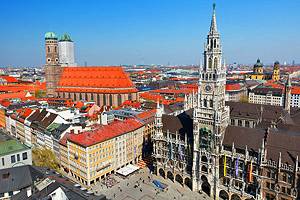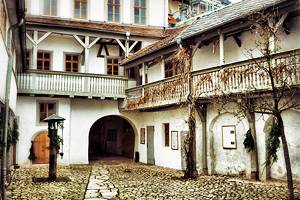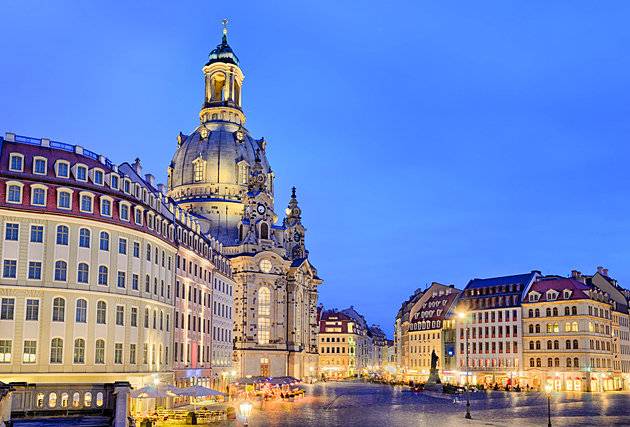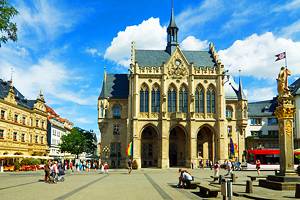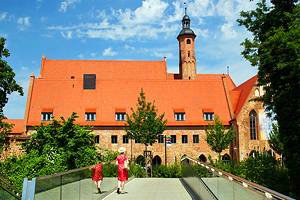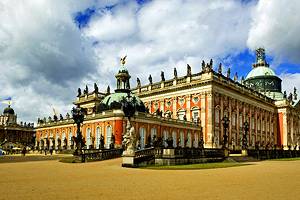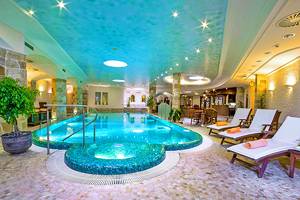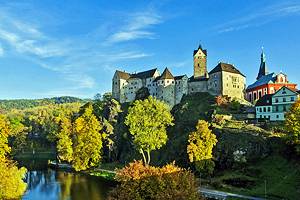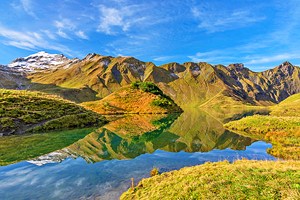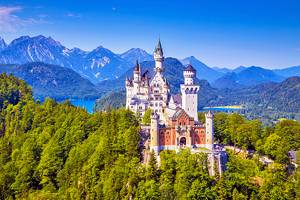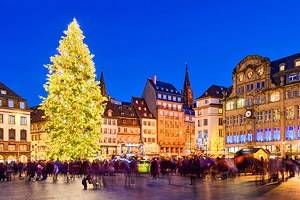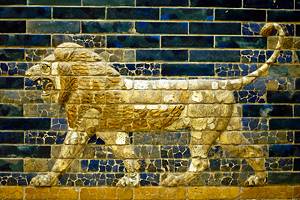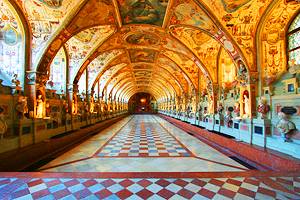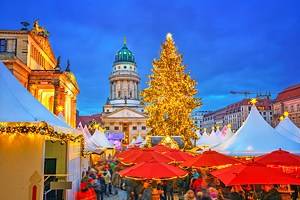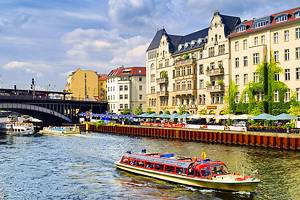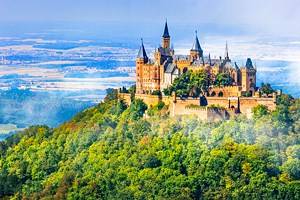Attractions & Things to Do in Leipzig
Germany's fastest-growing city, Leipzig is one of the most popular tourist destinations in eastern Germany, and thanks to its rich cultural and musical heritage, is regularly cited as one of the most livable cities in Europe. It's also cited as one of the continent's greenest cities, with one-third of its land covered in parks, green spaces, and forests.
A center of art and learning since the Middle Ages, as well as an important center for the book trade, it has long been a city of culture and was the home of Bach and Mendelssohn. Martin Luther preached here, and Goethe set scenes of Faust in one of its restaurants.
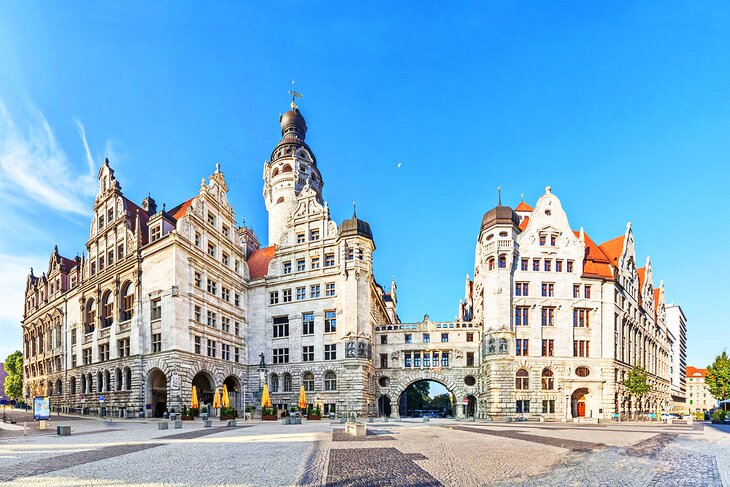
The city's attractions reflect all these and more. Music lovers will find concerts in the magnificent Gewandhaus, home of the world-famous Gewandhaus Orchestra, and in the church where Johann Sebastian Bach served as choirmaster; they can conduct a virtual orchestra at the home of Felix Mendelssohn, and pause for coffee and cake at Coffe Baum, a favorite of Schumann, Grieg, and Wagner.
The Leipzig zoo, one of Europe's best, is a favorite place to go with children, and families will also enjoy the ample parks. For tourists, it is a very manageable city, with many things to do right in the compact Old Town. If traveling by train, you will arrive at the grand Leipzig Central Station right in the heart of the city.
However close its attractions, don't think you can spend just one day in Leipzig — you will want time to see its excellent museums, pause for a concert in one of its churches, and savor the pastries in at least one of the coffeehouses it is famous for. Find the best places to visit with this handy list of the top tourist attractions and things to do in Leipzig.
- Markt and Old City Hall
- Hear the Music at St. Thomas Church
- St. Nicholas Church and the Miracle of Leipzig Monument
- Battle of the Nations Monument
- Leipzig Zoo
- Neues Gewandhaus
- Museum of Fine Arts
- Forum of Contemporary History (Zeitgeschichtliches Forum)
- Mädlerpassage and Naschmarkt
- Coffe Baum Coffee Museum
- Mendelssohn House
- Canoe or Bike along the Karl-Heine Canal and Weisse Elster
- Grassi Museum
- The Leipzig Cotton Mill
- Take a Day Trip to Torgau and Hartenfels Castle
- Leipzig University and the Paulinum
- Leipzig Botanical Garden
- Map of Attractions & Things to Do in Leipzig
Markt and Old City Hall
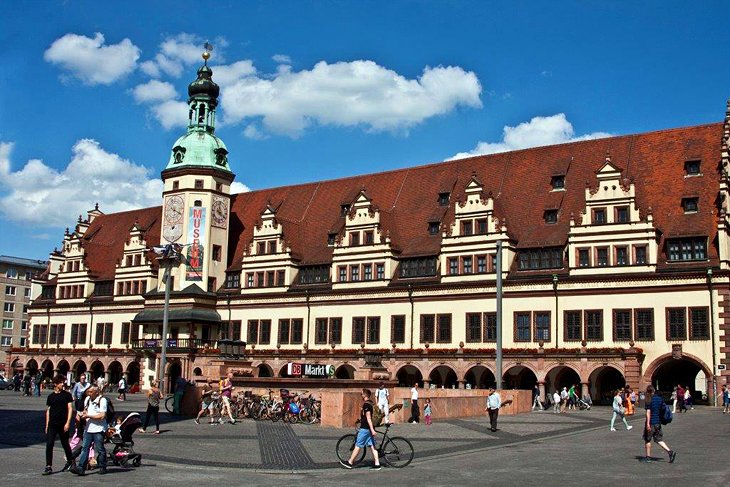
The Markt in Leipzig, for many centuries the hub of city life, is dominated by the Old City Hall (Rathaus), a Renaissance building erected in 1556 and considered one of the most beautiful Renaissance buildings in Germany. The tower, with its Baroque crown, is placed asymmetrically over the main entrance, above which is a roofed balcony used for public proclamations, often involving trumpeters in traditional costumes.
The colonnades along the front were built in 1907, replacing the wooden shops and booths that once stood here, but you'll still find shops under the arcade. Inside the Rathaus is a museum filled with artifacts and pictures from Leipzig's history, from its medieval fairs to the 1989 "peaceful revolution."
The large square is the scene of a farmers market, and during the city's many music festivals (the annual Bach Festival fills the city's churches and concert venues with music each June), it is fitted with a stage for performances.
Address: Markt 1, D-04109 Leipzig
Hear the Music at St. Thomas Church
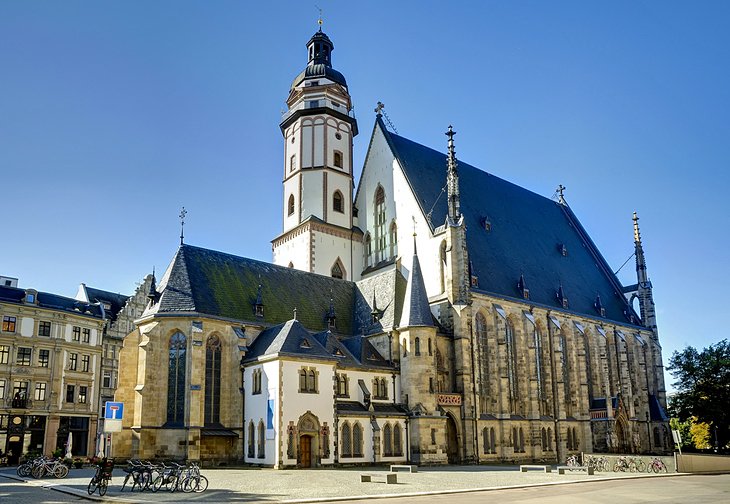
Southwest of Leipzig's Markt stands St. Thomas Church (Thomaskirche), home of the world-famous St. Thomas Boys' Choir. The choir dates from 1212, the year the church was built. Originally serving as an Augustinian monastery, St. Thomas was altered in later centuries, and in the 15th century was given the form of a Late Gothic hall-church, a style popular in Upper Saxony.
The west front dates from renovation work carried out between 1872 and 1889. Martin Luther preached here in 1539, and the church choir became a center of Protestant sacred music. Frequent choir and organ concerts, twice-weekly motets, Bach Passion concerts, and the Christmas Oratorio draw music lovers to St. Thomas throughout the year.
Johann Sebastian Bach was the church's choirmaster from 1723 to 1750, and his remains are interred here. Outside the church in a small square stands a statue of Bach, commemorating his years as choirmaster. Opposite the church is the Bosehaus, home of the Bach Research Institute and Memorial and the Bach Archives.
Address: Thomaskirchhof 18, 04103 Leipzig
St. Nicholas Church and the Miracle of Leipzig Monument
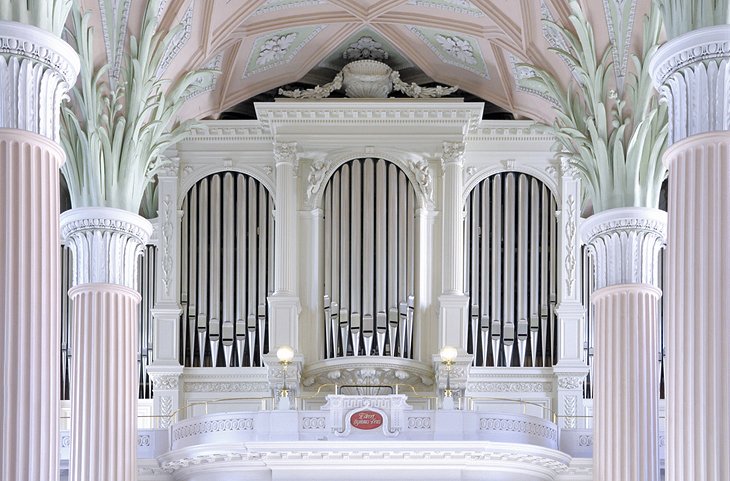
Built in the 12th century, St. Nicholas Church (Nikolaikirche) has been altered in various ways over the centuries, the most recent transforming its interior into the Neoclassical style in the 1700s. The entire interior is white, and its fluted columns rise to capitals from which palm fronds seem to spring out and support the groined ceiling.
It's a surprising flourish to an otherwise Neoclassical interior. Several works by Johann Sebastian Bach, who was music director both here and at St. Thomas Church, premiered here, and the church's organ is known for being one of the finest in Europe.
In the Nikolaikirchhof square outside, a monument echoing the design of the columns and their palm capitals commemorates the church's role as the rallying point for demonstrations against communist rule in East Germany in 1989. This uprising, known as Monday Demonstrations, began spontaneously, not planned or organized, in Leipzig following the weekly Friedensgebet (prayer for peace) in the St. Nicholas Church on September 4, 1989.
These continued each Monday, to the growing alarm of the communist government, until on October 9 about 70,000 peaceful demonstrators carrying lighted candles faced an armed security force of 8,000, who had been given orders to shoot. The size of the crowd and their non-violence convinced the forces not to fire, and the result became known as the Miracle of Leipzig. As news of the night spread, similar demonstrations were repeated in other East German cities, eventually leading to the reunification of Germany.
Address: Nikolaikirchhof 3, 04109 Leipzig
Battle of the Nations Monument
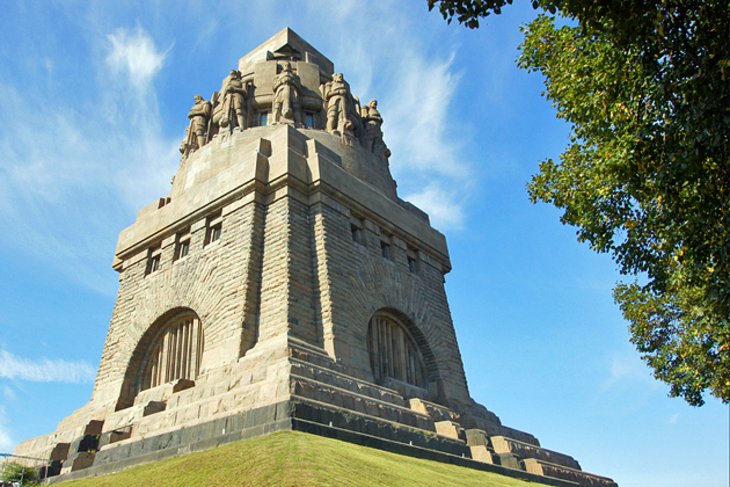
One of Germany's most important monuments — and a leading example of the Wilhelmine school of architecture — is the imposing Battle of the Nations Monument, the Volkerschlachtdenkmal. The largest war memorial in Europe, it was completed in 1913 to commemorate the 100th Anniversary of Napoleon's defeat at the Battle of the Nations in Leipzig in 1813.
On this battlefield, nearly 600,000 soldiers clashed in the largest battle in Europe prior to World War I. Napoleon's army was decisively defeated and forced to retreat to France, eventually leading to his exile to Elba the following year.
Heroic statues, 12 meters tall, surround the monument and its interior chamber, and there's a spectacular view from the viewing platform, 91 meters above (it's a long climb and there is no elevator). Below the monument is a museum about the Battle of Leipzig, illustrating the equipment and the military life of the soldiers who fought here. The monument is a 15-minute tram ride from the city center.
Address: Straße des 18 Oktober 100, 04299 Leipzig
Leipzig Zoo

More than just a day's outing for children, Zoo Leipzig is among Germany's best, where 850 different animal species live in habitats very close to their natural homes. Here, you can watch through an underwater glass wall as elephants swim, be greeted by the calls of black howler monkeys, see penguins play, look for alligators in the murky re-creation of the Everglades and find shy koalas lazing in their own eucalyptus forest.
In tropical environments, meet Germany's only Komodo Dragon, a lizard that can grow up to three meters long; drift in a boat through a rainforest inhabited by 100 exotic animal species; walk jungle paths; or get a bird's-eye view across the lush green canopy from the treetop trail. More than 24,000 plants create a tropical environment, where you can also see a garden with 60 exotic fruits and spices growing.
Enter a volcano tunnel to meet living fossils, creatures that look just as they did millions of years ago, or watch Amur tigers — the world's largest cats — in a Siberian landscape. Sit on the terrace of the Kiwara Lodge to enjoy the panoramic view of the savannah as giraffes munch on leaves and zebras gallop past ostriches, oryx, gazelles, and flamingos.
Added in 2017, the high-mountain landscape of the Himalayas is home to the zoo's snow leopards and red pandas, and the renovated walk-in aviary housing griffon vultures. One of Germany's largest aquariums holds an underwater world of colorful fish and living corals, where reef sharks and other species swim in circles around visitors.
Address: Pfaffendorfer Str. 29, Leipzig
Neues Gewandhaus

Immediately east of the University in Leipzig is the Gewandhaus, the magnificent home of the world-famous Gewandhaus Orchestra. Built in 1981, the three-story hall is decorated with paintings by modern artists and is well known for its excellent acoustics.
In the Grosser Saal, the main concert hall is one of the city's two Schuke organs (the other is at St. Thomas Church). In addition to its first-rate concert program, the hall hosts organ concerts during the Bach Festival in June and a number of other special events.
Address: Augustusplatz 8, 04109 Leipzig
Museum of Fine Arts
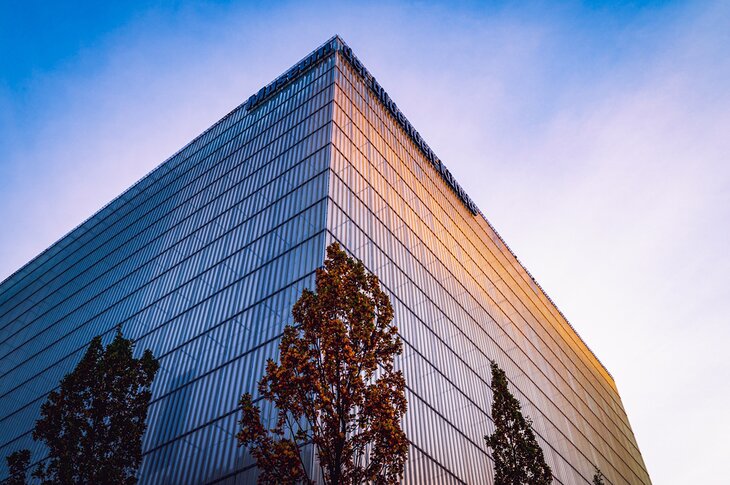
Although housed in one of Leipzig's newest architectural wonders, the Museum of Fine Arts (Museum der bildenden Künste) was in fact founded in 1837 and only settled into its new large-cubed home in 2004. One of Germany's most important national cultural institutions, the museum contains more than 3,500 paintings from the Middle Ages to the present, including works by Dutch, German, and Italian Masters.
While the museum displays few works by "big name" Old Masters — works by Frans Hals and a unique collection of 18 works by the two Lucas Cranachs being the exceptions — the collection of more than 400 paintings by 17th-century Dutch artists is exceptional in showing the development of this school.
More than 700 19th-century German works illustrate the progression from Classical to Romantic to Impressionism to Symbolism. The collection of 55,000 drawings and graphics includes works by William Hogarth, Daniel Chodowiecki, and Anton von Dyck, and the museum holds the definitive collection of works in all genres by Max Klinger, including 70 sculptures.
The building itself is a glass cube, 36 meters high, with its courtyards and terraces, where some of the larger three-dimensional works are displayed, visible from the outside. Its design is intended to reflect Leipzig's traditional passages.
Address: Katharinenstrasse 10, 04109 Leipzig
Forum of Contemporary History (Zeitgeschichtliches Forum)
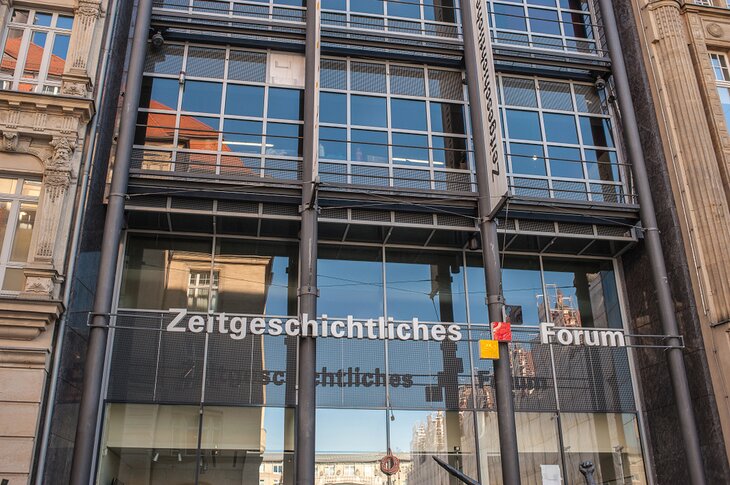
Through objects, photographs, recorded accounts, films, and thousands of artifacts, the Forum of Contemporary History tells the story of Germany from the end of World War II in 1945 until the Peaceful Revolution of 1989 and the subsequent reunification of Germany.
There is a heavy focus on everyday life for Germans under the communist dictatorship in the Soviet Occupation Zone, and on the opposition and civil disobedience to the repression of the Socialist Unity Party.
Permanent exhibitions examine the changes and challenges that reunification brought and consider the influences of globalization, international terrorism, and the digital revolution on the process of melding the two societies that had lived under such different economic and governmental systems.
If you are interested in a further look at Germany under the Communist occupation, visit the Stasi Museum and Memorial in the former headquarters of the "Stasi," the oppressive secret service of the former GDR. Admission to both museums is free.
Address: Grimmaische Str. 6, Leipzig, Germany
Mädlerpassage and Naschmarkt
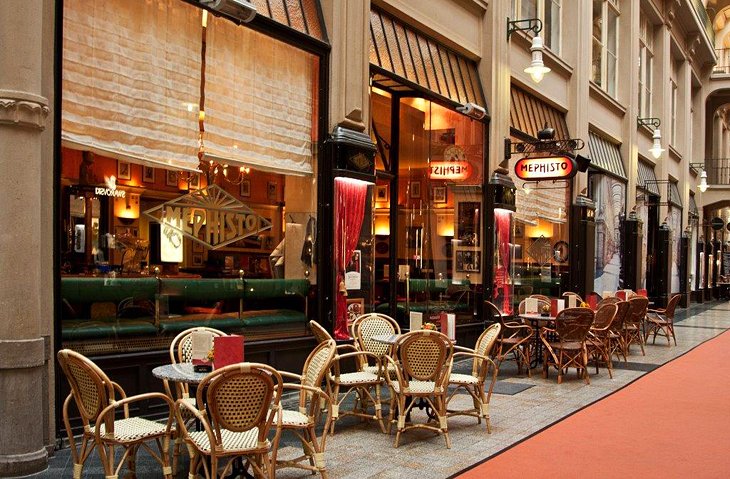
Opposite one end of the Old City Hall is the entrance to the Mädlerpassage, one of the charming old shopping arcades that tunnel through buildings in the heart of the old city. It leads to two other passages, Königshofpassage and Messehofpassage. Originally connecting merchants' houses and shops in the trade fair days, these covered alleyways protected tradesmen from the weather, and gradually they became the elegant arcades they are today.
Other European cities have such passages, but nowhere else is such an extensive network preserved. These covered streets are worth exploring for the shops, cafés, and restaurants they hide, and for their fascinating décor. At several points, they open out into covered courtyards, and elsewhere smaller passages intersect.
Decorations range from a beautiful tooled leather ceiling to a courtyard with modern tile artwork. In the Mädlerpassage, look for the statue of Faust and Mephistopheles in front of Auerbach's Keller, one of the most popular restaurants in Leipzig and where Goethe set the infamous cellar scene (Goethe was a frequent guest of the Keller, as was Martin Luther).
Opposite the entrance to the Mädlerpassage, behind the Old City Hall, is the Naschmarkt, a quiet little square laid out in 1556. On the north side is the Old Commercial Exchange (Alte Handelsbörse), an Early Baroque building dating from 1678.
Coffe Baum Coffee Museum
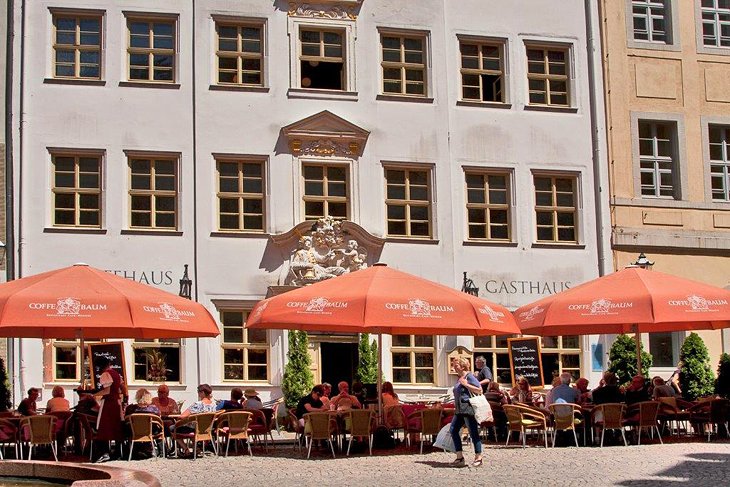
One of the oldest coffee shops in Europe still in its original form, Coffe Baum opened in 1717.
Coffe Baum honors that heritage with a museum of coffee that fills 15 rooms on the upper floors of the historic building. More than 500 artifacts trace the history of coffee itself and the rise of the coffee house culture in Saxony — where many believe the German obsession with coffeehouses began.
Displays include roasters, various methods and machines for brewing coffee, vintage containers and advertising, early porcelain coffee cups, and the leather cases made to protect them. The museum is free, but you won't be able to pass the display case in the café without stopping for a slice of their signature Baumkuchen.
Address: Kleine Fleischergasse 4, 04109 Leipzig
Mendelssohn House
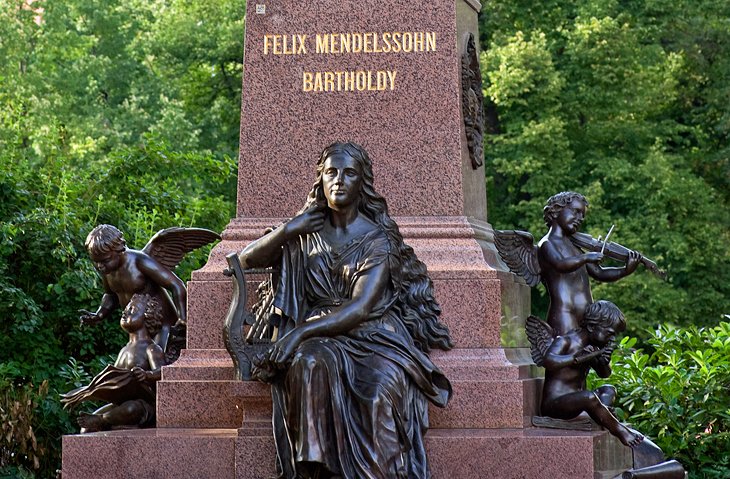
The Mendelssohn House in Leipzig is the only authentically preserved residence of the great composer, Felix Mendelssohn Bartholdy. Originally built in 1844, and occupied by the composer and his family from 1845, the house has been restored according to the original plans and furnished in the late Biedermeier style popular at the time.
In his study and music salon are personal belongings, sheet music, and watercolor paintings by Mendelssohn, as well as documents and displays relating to his life and work.
In 2014, new interactive features were added to the museum, including a video library and the "Effektorium" — a conductor's podium where visitors can conduct a virtual orchestra. The music salon is used, as it was in Mendelssohn's days, for weekly Sunday Concerts, Leipzig's Piano Summer. A statue of Mendelssohn stands in a small park outside St. Thomas Church.
Address: Goldschmidtstrasse 12, D-04103 Leipzig
Canoe or Bike along the Karl-Heine Canal and Weisse Elster
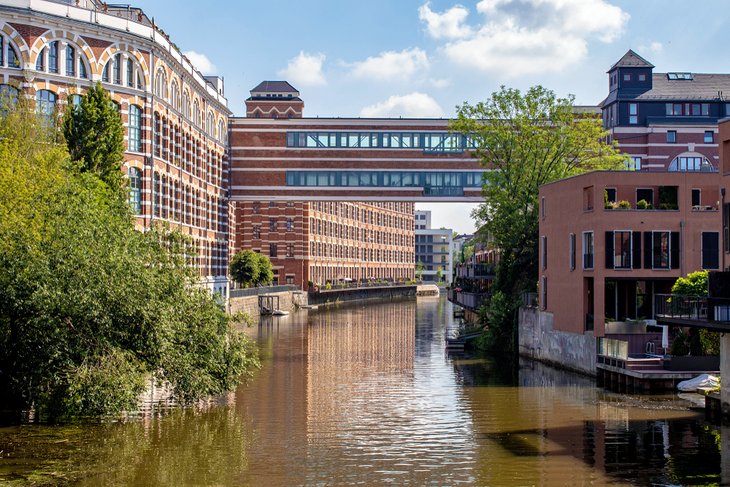
The Karl-Heine Canal leads from the river Weisse Elster through the old industrial district of Plagwitz, past beautiful brick industrial buildings and under tree-lined banks. The canal, Weisse Elster, and other waterways form an interlocking system of natural rivers and canals, a web of opportunities to discover another side of Leipzig.
The canal and some rivers are bordered by walking and bicycle paths, and wind through residential, industrial, and natural areas.
Waterside landmarks include the beautiful brick Buntgarnwerke Leipzig, built in 1875, Europe's largest architectural complex in Wilhelminian style. You can paddle under massive stone arched bridges, past the 1867 racecourse at Scheibenholz, and the impressive villa of the Baedeker family of guidebook fame.
Rent kayaks at Stadthafen Leipzig, the city's harbor, to paddle on your own, or join a canoe tour at the harbor to discover the waterways with a guide. You can rent bicycles at the harbor or at other locations around the city, or contact either nextbike or the Deutsche Bahn's Call a Bike service.
Grassi Museum
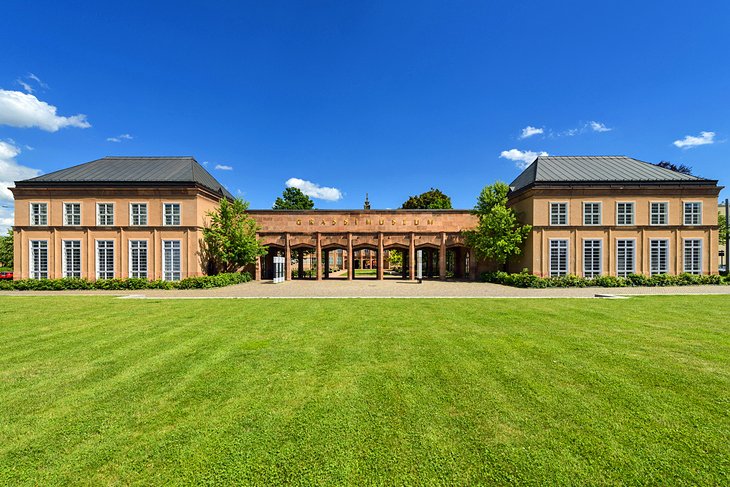
The Grassi Museum was established in 1895 and moved to its current home in 1929. The building is in fact three excellent museums in one, housing the city's ethnography, applied and decorative arts, and musical instrument collections.
The Museum of Musical Instruments is a particular favorite for visitors and includes instruments from the Middle Ages to the 20th century, as well as hands-on sound laboratories and extensive archives. Be sure to take a stroll through the city's impressive train station. Built in 1915, it is the largest railroad terminal in Europe.
Address: Johannisplatz 5-11, 04103 Leipzig
The Leipzig Cotton Mill
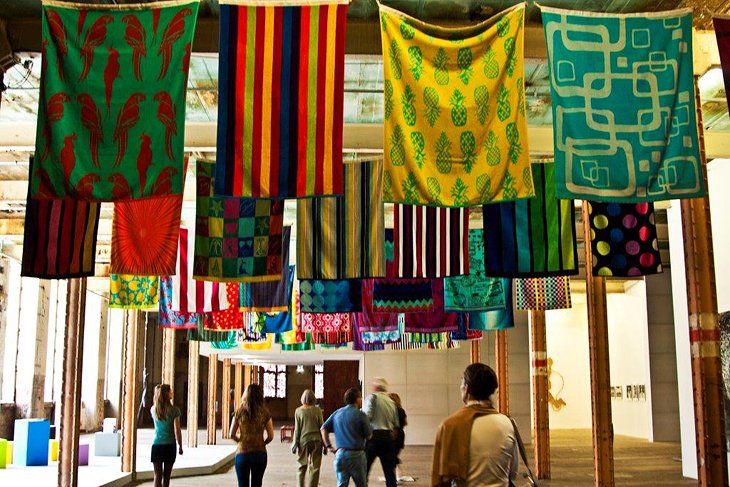
An area that's becoming increasingly interesting to explore is the Leipziger Baumwollspinnerei, the Leipzig Cotton Mill, in the district of Lindenau. This 10-hectare former industrial site was an important commercial center focusing on the cotton trade. At its peak before WWI, the complex formed a complete community that included 20 factories, homes, schools, and parks, along with more than 240,000 spindles.
In the past two decades, the Spinnerei has been transformed into a cultural destination, with art galleries, vast exhibition spaces, art studios, and workshops. About 100 artists, including fashion and other designers, printers, potters, sculptors, a goldsmith, and porcelain manufacturer, have settled here, and the complex is also home to a café, restaurants, and a film club.
The largest of the Spinnerei buildings has become a non-profit center for contemporary art, and the entire complex is the epicenter of Leipzig's vibrant art scene and the "New Leipzig School." A highlight of the complex is what may be Europe's largest and most comprehensive art supply store, a vast supermarket of art and craft materials and tools; an entire wall is devoted to brushes alone. To get there, take tram 14 from Leipzig Bahnhof to the S-Bahn Plagwitz station.
Address: Spinnereistraße 7, 04179 Leipzig
Take a Day Trip to Torgau and Hartenfels Castle
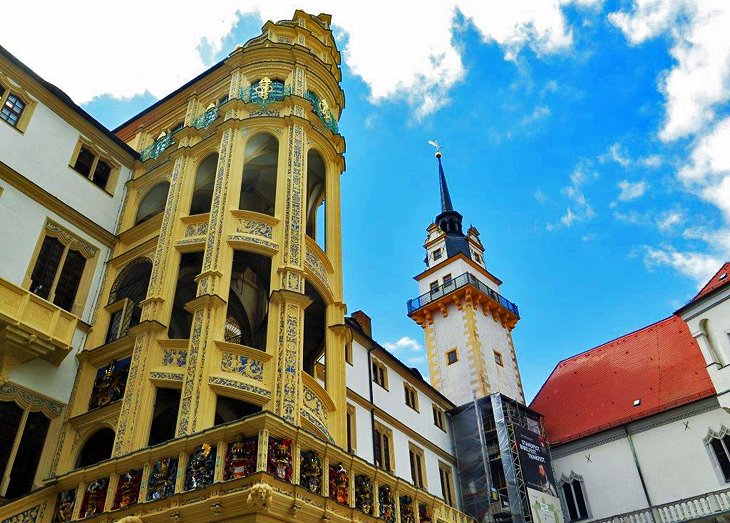
About an hour from Leipzig by car or 45 minutes by train, the hilltop town of Torgau is one of the major sites connected with Martin Luther and the Reformation. It was the political center of the Reformation, where Luther wrote some of his most significant works. The first Protestant songbook was published here, and it was where the Protestant rulers signed the Torgau League of Princes.
The town is dominated by the early Renaissance Hartenfels Castle, and it was in its wing that the world's first Protestant church was built, according to Luther's ideas, and consecrated by him in 1544. A beautiful spiral staircase rises from its broad courtyard, constructed without a central supporting column. The staircase and the Schöner Erker, a richly decorated oriel window dating from 1543, have been restored to their Renaissance splendor.
Luther's wife, Katharina von Bora, died in Torgau, and her grave memorial is one of the treasures of the church of St. Marien. Her house, where she died in 1552, is a museum, one of more than 500 late-Gothic and Renaissance buildings in Torgau. The beautifully decorated City Hall overlooks Torgau's market square, surrounded by other restored Renaissance buildings.
A monument in Torgau commemorates the meeting here of eastward-advancing US troops and westward-moving Soviet troops on April 25, 1945, signaling the approaching end of World War II.
Leipzig University and the Paulinum
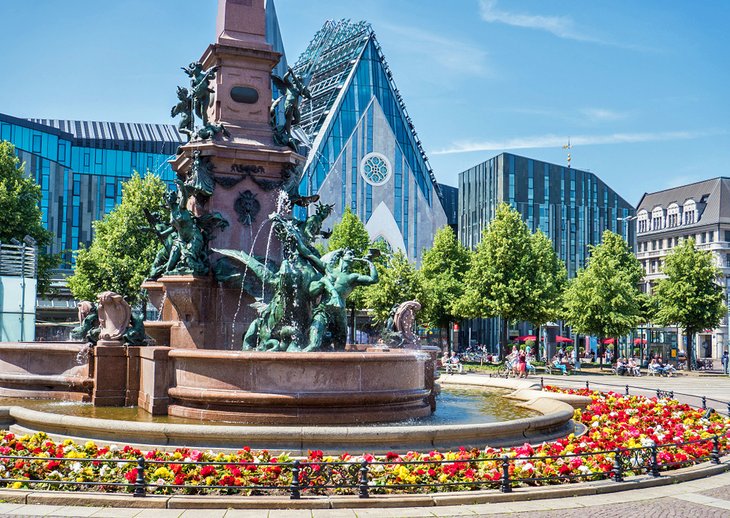
The dominant feature in Augustusplatz is the 34-story building occupied by Leipzig University, with its lofty café, Panorama Tower - Plate of Art, at 110 meters above the city. One of the world's oldest universities — and the second oldest in Germany — Leipzig University was founded in 1409, and more than 60 percent of its buildings were destroyed in World War II.
Surviving the war undamaged, only to be destroyed by dynamite in 1968 under the Soviet occupation, the Paulinerkirche was built in 1231 for the Dominican monastery and inaugurated by Martin Luther in 1545 after the Protestant Reformation.
In 2007, construction began on the Paulinum, in the exact location of the former church and reflecting its Gothic architecture.
Inside the Post-modern exterior, the soaring nave reflects its Gothic predecessor with rows of reeded columns rising to an intricate vaulted ceiling. The Paulineraltar, the Gothic altar, was saved from the original church and, along with several large polychrome sculptural works, relieves the stark white of the interior. The hall is now used primarily as a concert venue.
The university is home to four museums: the Egyptian Museum; the Museum for Musical Instruments; the Museum of Antiquities; and the University Art Collection, with paintings and sculptures dating back to the Middle Ages.
Incorporated in the lecture theater block is the Schinkeltor from 1836 and the surviving entrance to the old university, the Augusteum. Of interest nearby is the old Moritzbastei, a bastion dating back to 1515 and the only relic of the town's old fortifications.
Leipzig Botanical Garden
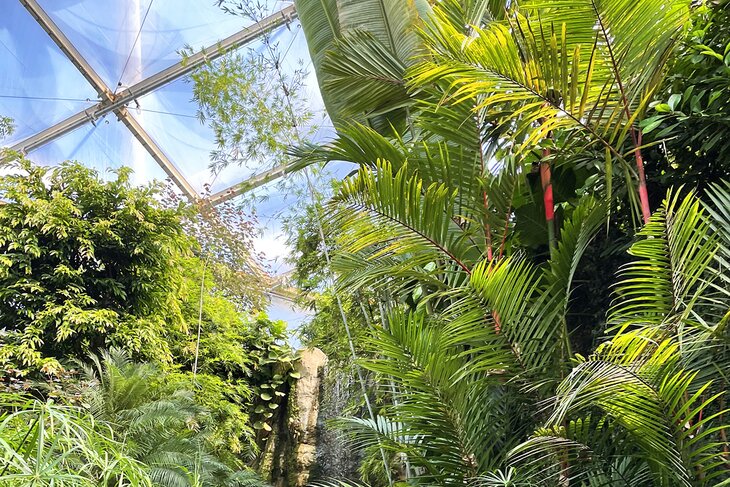
The Leipziger Botanische Gärten can trace its roots back as far as 1542 as the medicinal plant garden for the former Dominican monastery of St. Paul, in Augustusplatz. It was re-established at the current site in 1877.
Despite devastation during World War II, this nine-acre site features 4,500 species of plants representing in 1800 genera, with examples from Eastern Europe, North America, Asia, and South America. Highlights are the herb garden; the "scent and touch" garden; and the series of large greenhouses with cacti, subtropical, and tropical plants from around the world.
Address: Linnéstrasse 1, 04103 Leipzig
Map of Attractions & Things to Do in Leipzig
More Related Articles on PlanetWare.com

Places to Visit near Leipzig: Several fascinating cities are within an easy day trip from Leipzig. A 30-minute train ride takes you to the old university town of Wittenberg, the birthplace of Martin Luther's Reformation. A 40-minute train ride west of Leipzig, Erfurt also has connections to Martin Luther and has an interesting Jewish history as well.

Where to Go Next: Leipzig sits almost equidistant from eastern Germany's two most important cities, Dresden, with its magnificent palaces, and Germany's capital, Berlin, with its many museums and art galleries, both places you will want to spend some time exploring.




